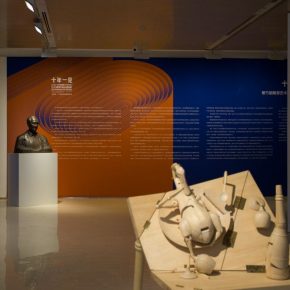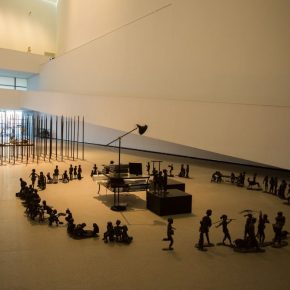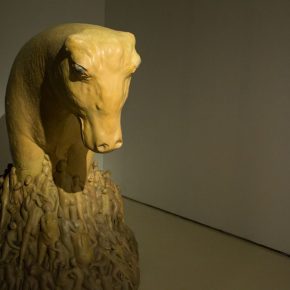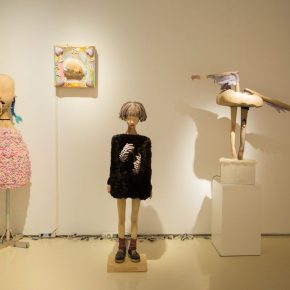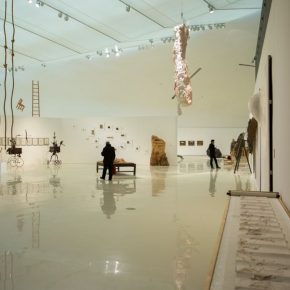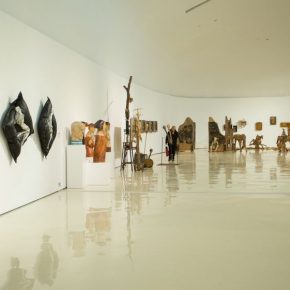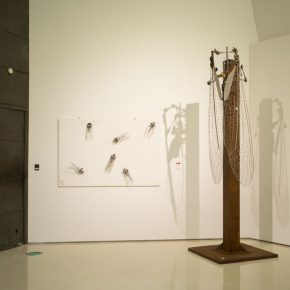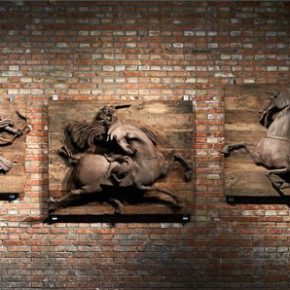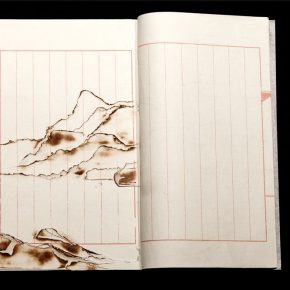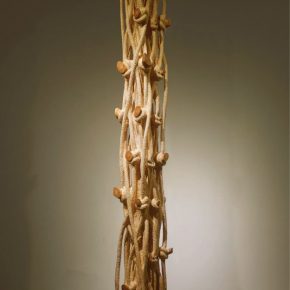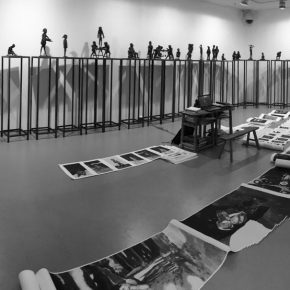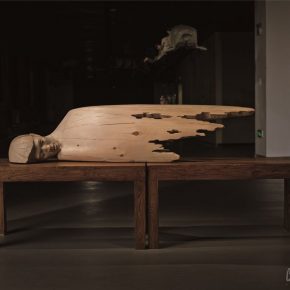
In 1903, the German poet R. M. Rilke wrote in his monograph on Rodin: The sculpture is independent, just like the painting on the easel, but it is different from painting, and the sculpture does not even need a roof to define it. It is an object which can exist independently. It also has the characteristics of a complete thing, that is, people can walk around it, or observe it from various perspectives... it must have its own specific position, and it must be set in a silent continuous space as well as various disciplines...its certainty, stability and nobility do not come from its importance, but from its harmonious coexistence with its surroundings.” This ancient category of art, whether as “a thing” or subject carrying commemorative significance, is also an important component of contemporary urban public art. Its intrinsic value is enriched infinitely in certain laws of the epochs.
As the first national sculpture scholarship in the history of modern Chinese sculpture, the “Zeng Zhushao Sculpture Fellowship” has reached a junction in its ten-year journey. While catering to young students in sculpture schools, it has gained a good reputation from both inside and outside this art field for its fair and impartial review mechanism, rigorous organizational structure and continuous influence. As a national sculpture art scholarship, which has experienced developments in a decade, it carries the growth process of a generation of young sculptors.
The National Tour Exhibition (Beijing Station) themed as “An Overview of the Decade: The National Exhibition of ‘Zeng Zhushao Sculpture Fellowship’ Award-winning Works” was unveiled at the CAFA Art Museum on the morning of January 8, 2019. The exhibition was organized by the Central Academy of Fine Arts, the China Sculpture Institute, the Association of Sculpture Arts Committee of China Artists Association and the Datong Municipal People’s Government. At the same time, the Youth Sculpture Forum which was composed of award-winning representatives and the Expert Forum with the theme of “Contemporary College Sculpture Education” were also successfully held.
From ten years of accumulation, the Fellowship has received a total of 934 pieces (sets) of works, of which 170 pieces (sets) of works won nomination awards, and 50 pieces (sets) of works won the “Zeng Zhushao Sculpture Fellowship.” Confronted with such huge data, it can be said that on the one hand, the Chinese sculpture is growing in strength; on the other hand, the “Zeng Zhushao Sculpture Fellowship” provides us with an objective clue. In the context of China, the history of the “development, transformation, and creation” of sculpture by youths has emerged faintly. At the same time, there is an ever-adjusting review vision, guiding standards, and college sculpture education that keeps pace with the times. What stories have been carried in “this great exploration in the history of Chinese sculpture” (Quote by Professor Lyu Pinchang)?
Once in a Decade: Ten years of Growth in Sculpture by Chinese Youths
The “Zeng Zhushao Sculpture Fellowship” was named after Mr. Zeng. Actually, it carries the spiritual value of the first generation of Chinese sculptors and an unremitting motivation. Mr. Zeng Zhushao (1908.07-2012.03) was born in Xiamen, Fujian Province. He lived in Myanmar in his childhood and returned to China in 1922. In 1928, he was admitted to the Department of Sculpture, National College of Art in Hangzhou. He went to France to study at the end of 1929 and studied music by himself. At the end of 1939, he returned to China from Marseille and then taught in Chongqing for more than ten years. In 1952, he was transferred to work at the Central Academy of Fine Arts. During the same period, he participated in the construction of the Monument to the People’s Heroes and creations on its relief sculptures. His representative works include the monumental relief sculpture “Burning Opium in Humen”, “Sun Yat-sen” in Zhongshan Park and “Cai Yuanpei” in Peking University, and he is one of the pioneers of modern sculpture in China.
Mr. Zeng is not just an outstanding sculptor, but also a pioneer in the education of new Chinese sculpture. He has made pioneering contributions to the sculpture development in China. During several decades when he taught at the Central Academy of Fine Arts, he advocated the research on the traditional Chinese sculpture and folk sculptures, and he has imparted practical experience and sculpture techniques to students. As President Fan Di’an talked about Mr. Zeng Zhushao, “His spirit of creation and academic character always endowed younger generations with the power of silent encouragement and set good examples for them. His sculptures are eternal with a rich historical consciousness, realistic concern and humanistic emotions. In teaching, he has always encouraged students to think independently while discovering and affirming the creative talents of students, thus he earned sincere respect from his inferiors.”
The background of the “Zeng Zhushao Sculpture Scholarship” is closely related to the development of Chinese contemporary sculpture. After 2000, new ideas were brought together and a group of young sculptors emerged, thus Chinese contemporary sculpture entered a youth era at the beginning of the millennium. In 2008, on the occasion of the 100th birthday of Mr. Zeng Zhushao, the Central Academy of Fine Arts and the China Sculpture Institute jointly advocated and initiated the establishment of the “Zeng Zhushao Sculpture Fellowship.” It is mainly aimed at the undergraduate and graduate students that will graduate from the school of sculpture each year. From 2008 to 2017, the exhibition and evaluation were held ten times. At the beginning, the Sculpture Department of the Central Academy of Fine Arts took the lead, and the schools of sculpture from the top 10 art colleges jointly participated in the exhibition. Each department recommended the works of five graduates to participate in the exhibition. By 2011, with the support of the Datong Municipal Government of Shanxi Province, the selection and exhibition of “Zeng Zhushao Sculpture Fellowship” were moved to the Chinese Sculpture Museum in Datong. The evaluation mechanism was also adjusted and expanded accordingly as it extends to the 18 sculpture departments of the national colleges and universities, the scholarship works include a total of 934 pieces (sets) of works, of which 170 pieces (sets) of works won nomination awards, and 50 pieces (sets) of works won the “Zeng Zhushao Sculpture Fellowship.”
Ten Years of Spirit: The Spiritual Archives of Young Artists
Before the opening of the exhibition, the “Zeng Zhushao Sculpture Fellowship” Youth Sculpture Forum was held. Four professors, Pi Daojian, Yin Shuangxi, Weng Jianqing and Wang Lin, formed an expert group to attend. Liu Qing (winner of 2009), Tan Jianming (winner of 2009), Shi Fu (winner of 2012) Huang Shan (winner of 2016) Tian Yedongxue (winner of 2018), five representatives respectively explained their experiences in sculpture art with their own creative process. Their individual characteristics may not cover the entire appearance of young sculptors, but they reflect the observation methods and thinking paths of some groups, and also highlight the criteria for judging fellowship.
Sculpture is an ancient proposition. Whether from an eastern or a western perspective it has its own unique development route, the youth group is the key strength pushing forward the development of sculpture. Although the artists all have their own perspectives and languages, their sense of responsibility, keen observation, and solid creativity sticks out a mile. When talking about the scholarship standard, Professor Sui Jianguo said: “There is no requirement for the subject matter, and no restriction on the style. The award focuses on the artist’s creativity.”
The “Zeng Zhushao Sculpture Fellowship” also has a certain means of recording. Professor Sun Zhenhua, the chief curator of the exhibition, and Professor Lyu(Lu) Pinchang from the Central Academy of Fine Arts all commented that, “the awards and exhibitions record the thoughts of the contemporary young sculpture students. In this sense, every exhibition is their spiritual archive.” In the era with advancements in ideas and technology, the Zeng Zhushao Sculpture Fellowship became a medium, showcasing the state of the most cutting-edge, emerging young sculptors.
Ten Years of Construction: Innovative Sculpture Art Education from Inheritance
“Towards Modernity: The 20th Century Chinese Sculpture Memorabilia” (edited by Yin Shuangxi) mentioned the words of Mr. Cai Yuanpei: “Music and architecture can both express the philosophy of life, but the most direct media is sculpture” (1906, Bingchen Year). Despite this idea was put forward more than a hundred years ago, if we regard “sculpture art as an external expression of the philosophy of life,” it still makes sense nowadays. Then, the sculpture that involves the philosophy of life, “how to teach? How do students learn? Or can sculpture be created from teaching?” Confronted with these problems, I am afraid that it cannot be solved for a while, and the issue of education with the times are still constantly changing, the key points of the issue are constantly innovating. On the afternoon of January 8, professors from dozens of colleges and universities, critics of sculpture art magazines, and some research experts in modern and contemporary art gathered together to discuss “Sculpture Education in Contemporary Colleges.”
Professor Sui Jianguo recalled his teaching experience from the establishment of the Fellowship. He said frankly, “A student’s creation is original, thus a teacher cannot control it. We can teach the students basic skills and then let them develop their own. The awards provide the students certain references, which also tell them that the direction of their efforts is not simply to learn, but to transcend it.”
Professor Sun Zhenhua talked about his feelings on the topic of “A Brief History of Today.” “Why should the school teach esoteric skills that are difficult to learn but lack of practicality? Can they be used? Is there any opportunity for students to use them?” Modern education has two aspects to explore: “smart education and awareness education”, teachers can train students to solve problems with the ability of basic technology, and on the other hand, the more important is the awareness of “feeling pain, joy, and hobbies.” In an era of rapid development, the ability of students to obtain information has been very prominent. College education should combine the orthodox “school classroom” with the non-mainstream “external classroom”, which can help students discover their own logic.
Through the “three growth stages in Chinese sculpture field” observed by the Chief Curator of the exhibition, Professor Sun Zhenhua, we can outline a contour: Firstly, the overall academic status of the sculpture discipline is growing, while the overall emphasis on the sculpture from the academic circle has increased; secondly, the growth of the comprehensive ability of young sculptors, they have combined “creating”, with their theoretical thinking and expressive skills; thirdly, through this event, the organizers from sculpture schools in China have gathered an experience in curating and cooperation. The “Zeng Zhushao Sculpture Fellowship” has shown us a rich picture with a decade of voyage. It is an accumulation of the ten-year development in Chinese youth sculpture events and behaviors, and a comprehensive review of sculptural teaching in Chinese art colleges. Meanwhile, based on the retrospective, the younger generation is still the backbone of the future of Chinese sculpture, and it is worth looking forward to the next decade.
Text (CN) by Zhang Yizhi, (EN) edited and translated by Sue/CAFA ART INFO
Photo by Hu Sichen, Work Photo Courtesy of the Organizers.


